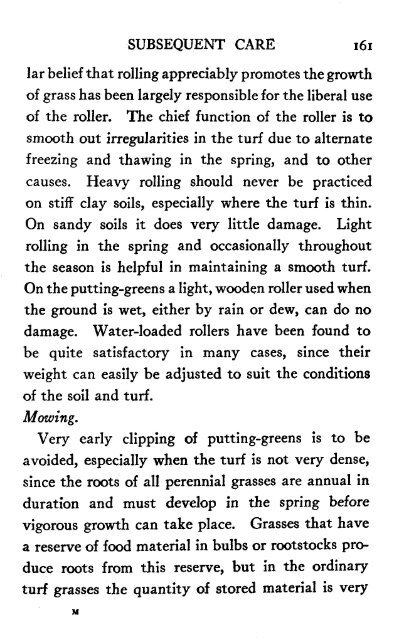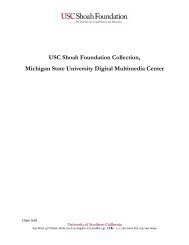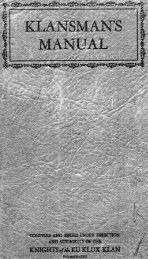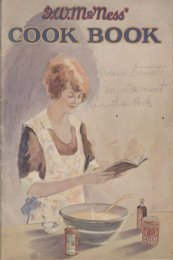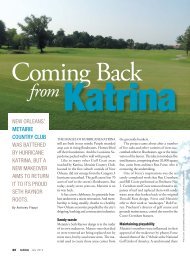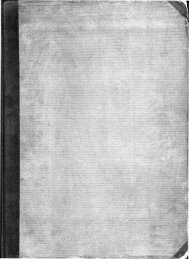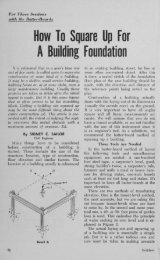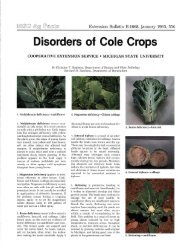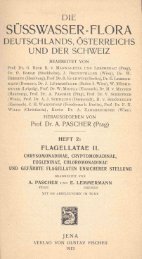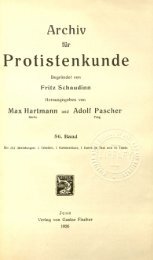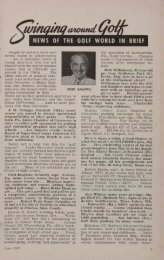- Page 4 and 5:
TURF FOR GOLF COURSES
- Page 7 and 8:
FOR GOLF TURF BY CHARLES V. PIPER A
- Page 9 and 10:
PREFACE THE remarkable development
- Page 11 and 12:
CONTENTS CHAPTER PAGES I. GENERAL V
- Page 13 and 14:
CONTENTS IX CHAPTaR PAGBS XIII. TUR
- Page 15 and 16:
xii ILLUSTRATIONS IN TEXT lIGllD: 1
- Page 17 and 18:
xiv ILLUSTRATIONS IN TEXT I'IGUIlE
- Page 19 and 20:
xvi PLATE PLATES PACING PAGE VII. T
- Page 21 and 22:
THE following pages contain adverti
- Page 23 and 24:
The Mystery of Golf By ARNOLD HAULT
- Page 25 and 26:
Handbook of Athletic Games By JESSI
- Page 27 and 28:
TURF FOR GOLF COURSES CHAPTER I GEN
- Page 29 and 30:
GENERAL VIEW in midsummer, but it a
- Page 31 and 32:
GENERAL VIEW 5 It is a very difficu
- Page 33 and 34:
GENERAL VIEW 7 Other northern turf
- Page 35 and 36:
GENERAL VIEW 9 grass in the North w
- Page 37 and 38:
SOILS FOR TURF GRASSES I I Most gol
- Page 39 and 40:
SOILS FOR TURF GRASSES 13 forming m
- Page 41 and 42:
SOILS FOR TURF GRASSES 15 are organ
- Page 43 and 44:
SOILS FOR TURF GRASSES 17 of good s
- Page 45 and 46:
SOILS FOR TURF GRASSES 19 peat. A s
- Page 48 and 49:
SOILS FOR TURF GRASSES 2 I most sat
- Page 50 and 51:
SOILS FOR TURF GRASSES 23 classifie
- Page 52 and 53:
SOILS FOR TURF GRASSES 2S condition
- Page 54 and 55:
SOILS FOR TURF GRASSES 27 While goo
- Page 56 and 57:
FERTILIZERS barnyard manure is an e
- Page 58 and 59:
FERTILIZERS 3 1 bone before grindin
- Page 60 and 61:
FERTILIZERS 33 worked into the turf
- Page 62 and 63:
FERTILIZERS 35 13 per cent of nitro
- Page 64 and 65:
FERTILIZERS 37 result of the format
- Page 66 and 67:
FERTILIZERS 39 The good commercial
- Page 68 and 69:
FERTILIZERS prevail in the minds of
- Page 70 and 71:
MANURES AND COMPOSTS 43 on putting-
- Page 72 and 73:
MANURES AND COMPOSTS 45 ment from t
- Page 75 and 76:
MANURES AND COMPOSTS 47 vegetable m
- Page 77 and 78:
MANURES AND COMPOSTS 49 occurs natu
- Page 79 and 80:
MANURES AND COMPOSTS 51 quality, bu
- Page 82 and 83:
CHAPTER V LIME AND ITs USE THE grea
- Page 84 and 85:
LIME AND ITS USE 55 three are the m
- Page 86 and 87:
CHAPTER VI THE IMPORTANT TURF PLANT
- Page 88 and 89:
THE IMPORTANT TURF PLANTS 59 Blue-g
- Page 90 and 91:
THE IMPORTANT TURF PLANTS 61 southe
- Page 92 and 93:
THE IMPORTANT TURF PLANTS 63 stripp
- Page 94 and 95:
THE IMPORTANT TURF PLANTS 65 but as
- Page 96 and 97:
THE IMPORTANT TURF PLANTS 67 northe
- Page 98 and 99:
THE IMPORTANT TURF PLANTS 69 Redtop
- Page 101 and 102:
THE IMPORTANT TURF PLANTS 71 Bent a
- Page 103 and 104:
THE IMPORTANT TURF PLANTS 73 bright
- Page 105 and 106:
THE IMPORTANT TURF PLANTS 75 cular
- Page 107 and 108:
THE IMPORTANT TURF PLANTS 77 FIG. 7
- Page 109 and 110:
THE IMPORTANT TURF PLANTS - 79 New
- Page 111 and 112:
THE IMPORTANT TURF PLANTS 81 grass
- Page 113 and 114:
THE IMPORTANT TURF PLANTS 83 BERMUD
- Page 115 and 116:
THE IMPORTANT TURF PLANTS 85 with t
- Page 117 and 118:
THE IMPORTANT TURF PLANTS 87 In pro
- Page 119 and 120:
THE IMPORTANT TURF PLANTS 89 able f
- Page 121 and 122:
THE IMPORTANT TURF PLANTS 91 course
- Page 123 and 124:
THE IMPORTANT TURF PLANTS 93 FIG. 1
- Page 125 and 126:
THE IMPORTANT TURF PLANTS 95 FIG. 1
- Page 127 and 128:
THE IMPORTANT TURF PLANTS 97 dent.
- Page 129 and 130:
THE IMPORTANT TURF PLANTS 99 terial
- Page 131 and 132:
THE IMPORTANT TURF PLANTS 101 this
- Page 133 and 134:
CHAPfER VII How TO DISTINGUISH DIFF
- Page 135 and 136:
HOW TO DISTINGUISH KINDS OF TURF 10
- Page 137 and 138:
HOW TO DISTINGUISH KINDS OF TURF 10
- Page 139 and 140:
HOW TO DISTINGUISH KINDS OF TURF lo
- Page 141 and 142:
HOW TO DISTINGUISH KINDS OF TURF II
- Page 143 and 144:
HOW TO DISTINGUISH KINDS OF TURF 11
- Page 146 and 147:
TURF GRASSES FOR DIFFERENT PURPOSES
- Page 149 and 150:
TURF GRASSES FOR DIFFERENT PURPOSES
- Page 151 and 152: TURF GRASSES FOR DIFFERENT PURPOSES
- Page 154 and 155: TURF GRASSES FOR DIFFERENT PURPOSES
- Page 156 and 157: TURF GRASSES FOR DIFFERENT PURPOSES
- Page 158 and 159: TURF GRASSES FOR DIFFERENT PURPOSES
- Page 160 and 161: TURF GRASSES FOR DIFFERENT PURPOSES
- Page 162 and 163: TURF GRASSES FOR DIFFERENT PURPOSES
- Page 164 and 165: TURF GRASSES FOR DIFFERENT PURPOSES
- Page 166 and 167: CHAPTER IX THE MAKING OF THE TURF A
- Page 169 and 170: THE MAKING OF THE TURF 135 is done
- Page 172 and 173: THE MAKING OF THE TURF 137 fairway
- Page 175 and 176: THE MAKING OF THE TURF 139 putting-
- Page 178 and 179: THE MAKING OF THE TURF 141 have a t
- Page 181 and 182: THE MAKING OF THE TURF 143 year wil
- Page 183 and 184: THE MAKING OF THE TURF 145 large kn
- Page 186 and 187: THE MAKING OF THE TURF 147 The need
- Page 189 and 190: THE MAKING OF THE TURF 149 Redtop s
- Page 192 and 193: THE MAKING OF THE TURF ISI price, a
- Page 194 and 195: Blue-grass IS rarely used on THE MA
- Page 196 and 197: SUBSEQUENT CARE 155 both soil and c
- Page 198 and 199: SUBSEQUENT CARE 157 Two, or possibl
- Page 200 and 201: SUBSEQUENT CARE [59 no manure or ot
- Page 204 and 205: SUBSEQUENT CARE IS helpful. Heavy w
- Page 206 and 207: SUBSEQUENT CARE Reseeding in the sp
- Page 208 and 209: SUBSEQUENT CARE not recognized unti
- Page 210 and 211: CHAPTER XI WEEDS AND THEIR CONTROL
- Page 212 and 213: WEEDS AND THEIR CONTROL 171 Common
- Page 214 and 215: WEEDS AND THEIR CONTROL 173 spontan
- Page 217 and 218: WEEDS AND THEIR CONTROL 175 acid. S
- Page 219 and 220: WEEDS AND THEIR CONTROL 177 by this
- Page 221 and 222: WEEDS AND THEIR CONTROL 179 occasio
- Page 223 and 224: WEEDS AND THEIR CONTROL 18[ Pigeon-
- Page 226 and 227: WEEDS AND THEIR CONTROL 183 (Plate
- Page 228 and 229: CHAPTER XII ANIMAL PESTS INSECTS an
- Page 230 and 231: ANIMAL PESTS not properly treated,
- Page 232 and 233: ANIMAL PESTS anything of this sort,
- Page 234 and 235: ANIMAL PESTS 191 to be treated. The
- Page 236 and 237: ANIMAL PESTS 193 Earthworms prefer
- Page 238 and 239: ANIMAL PESTS 195 Liquids, when spra
- Page 240 and 241: ANIMAL PESTS blesome in soil that h
- Page 242 and 243: ANIMAL PESTS 199 CRAWFISH On poorly
- Page 244 and 245: TURF MACHINERY 201 In the illustrat
- Page 246 and 247: TURF MACHINERY 203 A preliminary li
- Page 248 and 249: TURF MACHINERY 205 easily, cut the
- Page 250 and 251: EXPERIMENTAL WORK ON GOLF COURSES 2
- Page 252 and 253:
EXPERIMENTAL WORK ON GOLF COURSES 2
- Page 254 and 255:
EXPERIMENTAL WORK ON GOLF COURSES 2
- Page 257 and 258:
EXPERIMENTAL WORK ON GOLF COURSES 2
- Page 259 and 260:
EXPERIMENTAL WORK ON GOLF COURSES 2
- Page 261 and 262:
EXPERIMENTAL WORK ON GOLF COURSES 2
- Page 263 and 264:
EXPERIMENTAL WORK ON GOLF COURSES 2
- Page 265 and 266:
EXPERIMENTAL WORK ON GOLF COURSES 2
- Page 267 and 268:
CHAPTER XV PERSONAL EXPERIENCES AMO
- Page 270 and 271:
PERSONAL EXPERIENCES 225 night abso
- Page 272 and 273:
PERSONAL EXPERIENCES 227 artd he re
- Page 274 and 275:
PERSONAL EXPERIENCES 229 would dig
- Page 276 and 277:
PERSONAL EXPERIENCES 23 I construct
- Page 278 and 279:
PERSONAL EXPERIENCES 233 at all in
- Page 280 and 281:
PERSONAL EXPERIENCES 235 inch deep,
- Page 282 and 283:
PERSONAL EXPERIENCES 237 an interes
- Page 284 and 285:
PERSONAL EXPERIENCES 239 in a very
- Page 286 and 287:
PERSONAL EXPERIENCES 241 slightly c
- Page 288 and 289:
PERSONAL EXPERIENCES 243 greens, th
- Page 290 and 291:
PERSONAL EXPERIENCES 245 putting-gr
- Page 292 and 293:
PERSONAL EXPERIENCES 247 ing. Carel
- Page 295 and 296:
250 TURF FOR GOLF COURSES While the
- Page 297 and 298:
25 2 TURF FOR GOLF COURSES Chewings
- Page 299 and 300:
254 TURF FOR GOLF COURSES in, distr
- Page 301 and 302:
256 TURF FOR GOLF COURSES thing els
- Page 303 and 304:
Columbia Country Club, 243~2{8. ant
- Page 305 and 306:
260 INDEX Loam, 17. silt, 10. Loliu
- Page 307:
262 INDEX Soda, nitrate of, 35-37,


